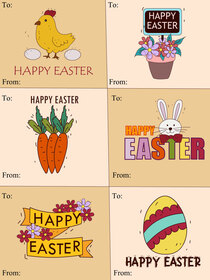OK. I’m done with winter. I am READY for it to make an exit. It’s been a pretty long and harsh few months and I can’t wait for warmer weather. Which, hopefully shouldn’t be too far away, considering Easter is around the corner. (April 4) So, have you thought about how to celebrate?

OK. I’m done with winter. I am READY for it to make an exit. It’s been a pretty long and harsh few months and I can’t wait for warmer weather. Which, hopefully shouldn’t be too far away, considering Easter is around the corner. (April 4) So, have you thought about how to celebrate?
No. I don’t mean how much you’ll spend on each Easter basket, or new clothes and hats, or on travel or whether you’ll tell your kids the story of the Easter bunny. But – how will you actually celebrate this wonderful time of the year? After all, the onset of spring is one of nature’s most spectacular displays. It’s not only pleasant on the eyes and a great time to venture outdoors after months of bitter weather, but it’s also symbolic. To many, spring also represent new beginnings of a different kind.
Now, my family doesn’t really celebrate Easter. But, in my online travels I stumbled upon some really cool Easter activities, crafts and games that I just couldn’t help paying attention to.
I know that the usual Easter egg hunt is fascinating in itself, at least for little ones. But sometimes, for us adults, doing the same things over and over again every year tends to get monotonous. Planning the same menu, cooking the same meals, the same shopping trips, the same gifts, the same holidays – sometimes you need to break away a little from tradition to value tradition. What do you think?
If you feel the same way and are game for some exciting new stuff to try this Easter, why not try to make up some your own traditions? After all – most of the customs and traditions associated with Easter and other holidays, including Christmas, revolve around the idea of making it appealing and fun for kids. Santa Claus, stockings, Easter bunny, basketful of treats…it’s all about getting the kids excited and to encourage their participation in the holiday.
So, what if you were to create new traditions based on your child’s individual personality or taste?
From making your own Easter basket or Easter bunny from an old sock (http://familyfun.go.com/easter/easter-bunny-crafts-recipes-printables/sock-hop-841022/), to paper crafts, to coming up with Easter games that the entire family could play- did you know that there are countless ways to personalize Easter? Or for that matter any holiday.
Age-old traditions are important and have their place.
However, sometimes, making up little traditions helps to keep the enthusiasm alive.
For example,
* Instead of sticking to the same menu, this year, why not experiment with a new dish to replace one of the usual items. Find a new recipe that you and your child could try out together.
* Or, instead of going for conventional Easter baskets and bunnies, why not spend a couple of afternoons making them from things readily available around your home. (http://familyfun.go.com/easter/easter-crafts/easter-baskets/bunny-basket-665124/). You could use the opportunity to talk about recycling and the environment, or simply have a good time ‘making’ something with your kids. It doesn’t matter how well the crafts turn out, as long as you both had a good time and keep the spirit of tradition alive.
* You could come up with an Easter game(http://www.garvick.com/annual/easter/easter-games.htm) and make it a tradition to play the game every year after Easter lunch. Or even come up with a new game every year.
* Or take a walk around your neighborhood and identify the different kinds of plants and trees, paying attention to the ones that already show signs of life.
* You could read up on the different ways in which spring is welcomed and celebrated around the world(http://www.huffingtonpost.com/2009/03/25/spring-holidays-around-th_n_178955.html)and maybe add a few global customs to your Easter celebrations.
With just a little thought and effort, you can turn Easter and every holiday in the year into an exciting learning opportunity for everyone and a family bonding experience. Who knows, your kids may even grow up boasting to their friends that their mom’s holiday traditions were the coolest!
Oh! And don’t forget to add sending free Easter ecards and giving each other free Printable Easter cards to your list of new holiday traditions. That’s something you can do regardless of how you celebrate Easter!!
 Has Spring worked its magic on you yet? It sure has lifted my spirits. This is the time of the year I feel most optimistic and confident. How about you?
Has Spring worked its magic on you yet? It sure has lifted my spirits. This is the time of the year I feel most optimistic and confident. How about you?






